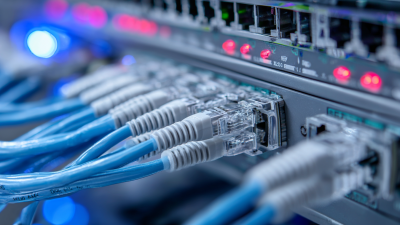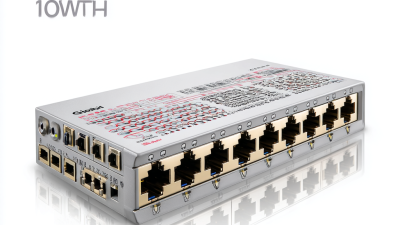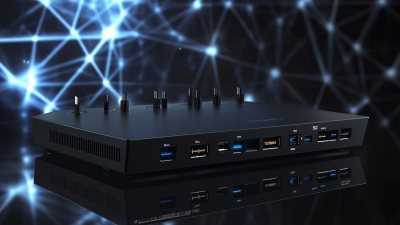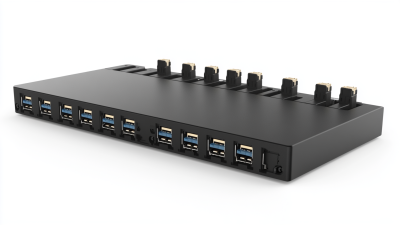
- hasivo@hasivo.com
- Mon - Sat at 7:00AM to 9:00PM
Leave Your Message

In today's fast-paced digital environment, achieving lightning-fast network performance is crucial for both individuals and businesses alike. The advent of the 2.5g Switch offers a powerful solution to this demand, bridging the gap between traditional Ethernet speeds and the emerging needs for higher data throughput. With its ability to provide significantly enhanced bandwidth, the 2.5g Switch revolutionizes connectivity, ensuring seamless data transfer and improved responsiveness in various applications.

This article delves into the myriad benefits of integrating a 2.5g Switch into your network infrastructure, showcasing how it empowers users to harness the full potential of their digital workflows.
From streaming high-definition content to supporting an increased number of connected devices, the implications of adopting this cutting-edge technology are profound, making the 2.5g Switch an indispensable tool for maximizing network performance in an increasingly interconnected world.
2.5G switches are revolutionizing network performance by bridging the gap between traditional Gigabit Ethernet and faster multi-gigabit capabilities. Designed to enhance data transfer speeds, these switches can manage higher bandwidth without the need for extensive infrastructure overhauls. Key features of 2.5G switches include support for high-speed connections, advanced Quality of Service (QoS) mechanisms to prioritize critical traffic, and enhanced security protocols to protect sensitive data. This combination makes them ideal for businesses that require reliable and swift network performance to support applications like video conferencing, online gaming, and data-heavy transfers.
Tips: When selecting a 2.5G switch, consider your current network demands and plan for future scalability. Ensure that your existing cabling can support the increased speeds, and check compatibility with your devices. Additionally, implementing a Layer 3 switch can significantly boost performance by allowing for smart traffic management, which is crucial in busy environments.
Investing in a 2.5G switch not only improves overall network efficiency but also future-proofs your infrastructure as businesses increasingly move towards higher-bandwidth applications. Incorporating features like Power over Ethernet (PoE) can further simplify connectivity for devices such as IP cameras and access points, streamlining your network setup while maximizing performance.
| Feature | Description | Advantage |
|---|---|---|
| Speed | Supports speeds up to 2.5 Gbps | Faster data transfer compared to standard gigabit switches |
| Port Density | Higher port counts for more extensive networking | Supports a larger number of devices without performance degradation |
| Backward Compatibility | Compatible with existing 1 Gbps and 100 Mbps devices | Allows for easy integration into existing networks |
| PoE Support | Power over Ethernet capabilities | Reduces the need for separate power supplies for devices |
| Advanced QoS | Quality of Service features for traffic prioritization | Ensures optimal performance for critical applications |
| Management Features | Supports SNMP, web management, and CLI | Simplifies network monitoring and troubleshooting |
Setting up a 2.5G switch can significantly enhance your network’s performance, paving the way for faster data transfer speeds and improved connectivity. According to a report by the Ethernet Alliance, the adoption of 2.5G Ethernet is projected to grow exponentially, with a CAGR of 25% from 2021 to 2026. This growth is driven by the increasing demand for reliable bandwidth in environments with heavy multimedia streaming and large data transfers.
To set up your 2.5G switch, begin by selecting the ideal location for the switch to minimize cable lengths and reduce latency. Connect your switch to the power supply and plug in the necessary Ethernet cables, ensuring they are Category 6 or higher to support 2.5G speeds. Utilize a network configuration tool to streamline the setup process; this can optimize the switch’s performance based on your specific requirements. Industry insights from IDC indicate that organizations upgrading to higher-speed networking solutions experience a 40% increase in overall operational efficiency. Thus, investing time in an effective setup not only boosts speed but also enhances productivity across the network.

The advent of 2.5G technology is revolutionizing network performance, particularly in environments demanding high-speed connectivity. As indicated by recent trends, the deployment of 2.5Gb/s residential services by internet providers has moved towards becoming the standard for modern broadband, doubling the upload and download capabilities typical of existing infrastructures. This advancement not only ensures superior data transmission rates but also enhances the overall user experience, paving the way for applications requiring rich media streaming, gaming, and smart home integrations that demand consistent and reliable connectivity.

Moreover, the integration of 2.5G switches with cutting-edge Wi-Fi 7 technology promises to optimize network performance significantly. Industry reports project that Wi-Fi 7 will support multi-gigabit speeds and improved latency, which complements the capabilities of 2.5G networks. The synergy between these technologies is particularly relevant as more consumers and businesses migrate towards high-bandwidth applications. With the increasing need for robust connectivity solutions, organizations are recognizing the strategic advantage that deploying 2.5G infrastructure brings—enabling them to meet not only current but also future networking demands effectively.
When dealing with 2.5G switches, users may encounter several common issues that can hinder their network performance. Connectivity problems often stem from improper configurations, such as incorrect VLAN settings or IP address conflicts, which can disrupt communication between devices. Additionally, outdated firmware may lead to instability, resulting in unexpected disconnections. Regularly checking and updating the switch settings can resolve many of these concerns, ensuring a smoother experience.
Another aspect to consider is the impact of physical connections. Poor-quality cables can contribute to performance degradation, so it’s essential to use compatible and high-quality Ethernet cables that support 2.5G speeds. Furthermore, environmental factors like overheating can affect the switch functionality. Implementing adequate cooling solutions and ensuring proper ventilation can mitigate this risk. By addressing these common issues, users can fully harness the power of their 2.5G switches, achieving lightning-fast network performance.
As organizations increasingly depend on robust digital connections, future-proofing networks with 2.5G solutions has become essential. With the advent of 2.5G technology, businesses can seamlessly enhance their network capacities, allowing for multi-gigabit speeds that meet the demands of modern applications. The recent introduction of innovative Point-to-Point Network Terminals exemplifies this trend, empowering users to achieve faster data transmission and improved performance across their infrastructures.
Moreover, as the tech landscape evolves towards Wi-Fi 7 and beyond, integrating 2.5G solutions ensures that networks can handle growing bandwidth requirements. These advancements not only facilitate higher speeds but also provide a solid foundation for future technologies, making them a wise investment for organizations seeking longevity in their network capabilities. Embracing these technologies positions businesses to effectively respond to the increasing demand for speed, reliability, and scalability in an ever-connected world.
This chart illustrates the comparison of network performance across different data rates, showcasing the advantages of 2.5G solutions over traditional 1G and 10G technologies in terms of latency and throughput.





